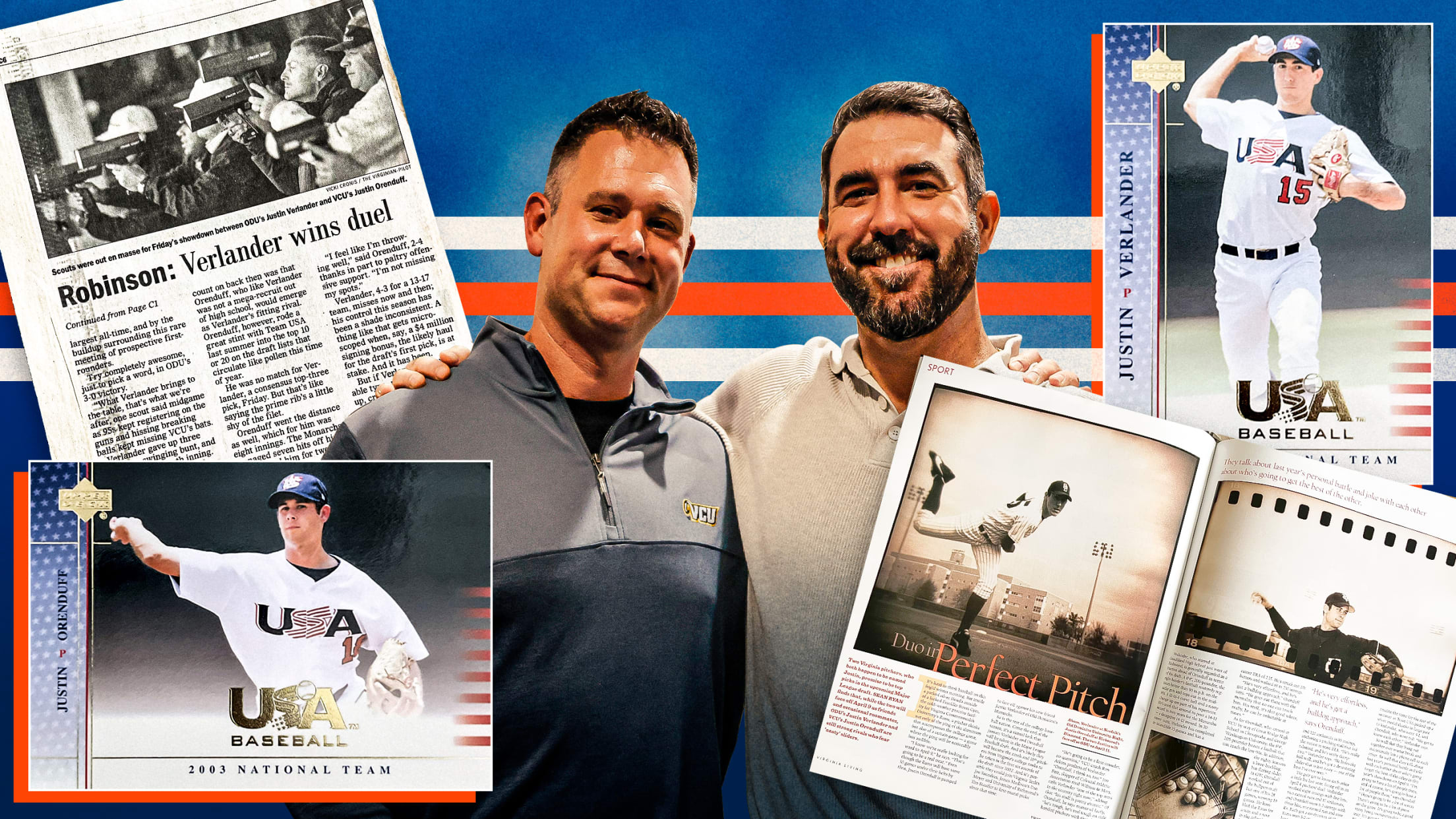
Once rivals, still friends: Verlander, Orenduff recount epic duel 20 years later

WASHINGTON -- Many around baseball were eager to see what Justin Verlander had left in the tank when he made his delayed first start of the 2024 season on April 19. The 41-year-old had missed the first few weeks with shoulder inflammation and while they say time is undefeated, both in baseball and in life, watching the sure-fire Hall of Famer fight back was must-see viewing.
No one was more dialed in than Justin Orenduff. Sitting back behind home plate, in seats left by Verlander, the former Minor League hurler makes evaluating pitching deliveries his business these days. The two Virginia natives have created a close bond over the past two decades, a relationship that combines friendship with technical pitching talk.
“Our friendship developed probably more so because we have the common bond of pitching,” said Orenduff, now 40. “And there’s a mutual respect about the teaching side, what goes into it. I’m not out there throwing the ball, but I care because I’m his friend and I’m just trying to help.”
That wasn’t always the dynamic. Now close friends, the two Justins were once rivals who faced off in one of the best college matchups among Draft prospects anyone has ever seen. On April 9, 2004, what seemed like all of the scouting industry crammed behind the plate at Old Dominion University’s Bud Matheny Baseball Complex to watch two of the better college arms in that year’s class take the same mound.
USA BASEBALL TEAMMATES
The relationship between Verlander and Orenduff actually started the summer prior to the big duel. Both were part of an impressive Team USA pitching staff that would help the Collegiate National Team reach the Gold Medal game of the 2003 Pan American Games. Neither was necessarily thought to be the best arm on the team, nor the most well-known. That honor probably belonged to Long Beach State right-hander Jered Weaver, who would go on to be the No. 12 overall pick in the 2004 Draft and spend a dozen years in the big leagues.
Verlander might have been considered No. 2 on that staff; Orenduff, from Virginia Commonwealth, and Stanford’s Mark Romanczuk, a 2005 draftee, rounded out the rotation. All of them, along with closer Huston Street, threw extremely well and Team USA finished with a 1.29 ERA. Verlander had a 1.34 ERA and .188 batting average against. Orenduff was just as stingy, compiling a 1.31 ERA and .170 BAA while happily taking a back seat to the big names.
“To be honest, the whole summer leading up to that, the conversation for me on Team USA was mostly, well Justin Orenduff is doing good, but Justin Verlander and, at the time, Jered Weaver, were the two best right-handed prospects in college baseball,” Orenduff said. “There was no pressure on me. I could just go and pitch and do whatever I wanted to do.”
The pair wasn’t tight, yet. They were throwing partners and, perhaps in a sign of what Orenduff’s calling would be once he was forced off the mound in the Minor Leagues because of injury, he knew right away that what he shouldn’t do was compare himself to Verlander.
“It was a good basis for me from playing catch with him every day; there were things physically he did that I couldn’t do,” Orenduff said. “My standard wasn’t to be him, it was to be me and try to compete and do the best job I can. For me, leading into the game, I knew what I could do. The year before, VCU beat ODU. No one knew about me at that point, it wasn’t the billing of the junior game.”
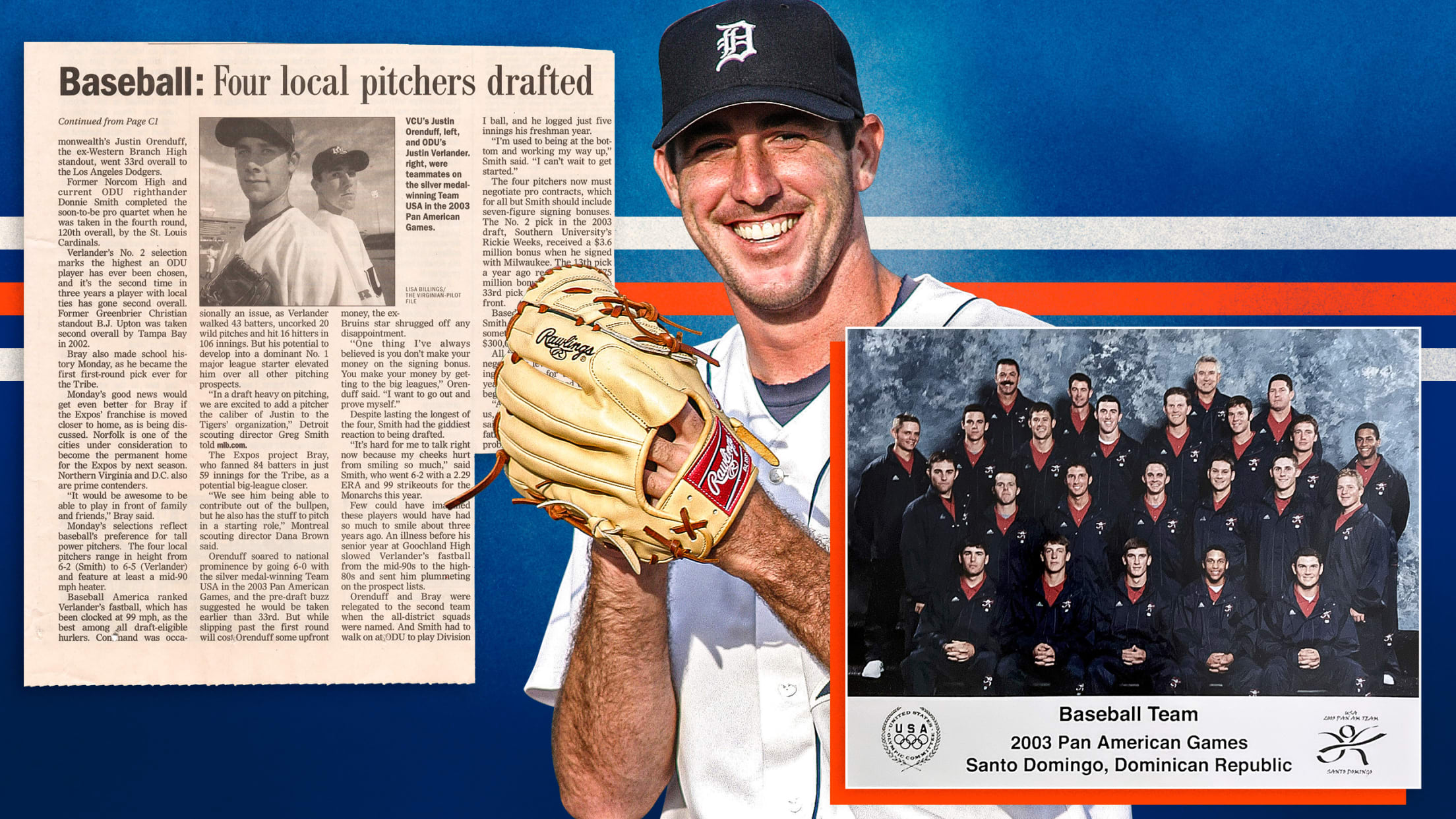
SCOUTS FLOOD TO NORFOLK
By the time April 9 rolled around, it was pretty clear that Verlander was going to be one of the first players taken in the Draft, rising to the top of what was a strong crop of college pitchers. In addition to Weaver at Long Beach State, Rice University had a trio of future top 10 picks in Philip Humber, Jeff Niemann and Wade Townsend (they would go 3, 4 and 8 overall) and Vanderbilt had lefty Jeremy Sowers. Seven college arms ended up going in the top 12 overall.
From the back seat, as he would call it, Orenduff was polishing his own first-round credentials, and he would eventually go No. 33 overall, in the compensation round, to the Dodgers. Friday, April 9, might have been circled in pencil after both starred for Team USA and were expected to lead their schools' rotations. As the spring unfolded, it became a must-stop, two-for-one deal.
“As a scout, you have to get bang for your buck,” Verlander recalled. “You come to see two studs for one game. Everybody was there, all the big guys.
“It was by far the most amount of scouts I’d seen at a game. I remember taking the mound … at Bud Matheny Stadium, there was a cutout behind home at field level. When I first started warming up, I saw a swath of people. I’d never seen that many scouts, probably 100 plus. It was a lot.”
While the two aces weren’t yet the friends they are today, there was the bond forged from being on Team USA together. The pair was going through their pregame routines, which back then included running foul line to foul line when their paths met.
“I remember warming up before the game, it was a custom to jog poles before you warmed up,” Orenduff said. “We both kind of met in right field. It was a little awkward because we knew we had to compete against each other. I think I was like, ‘Hey man, best of luck.’ And he said, ‘Well, there’s no luck. We’re just going to try to beat each other.’”
“Toe to toe,” Verlander chimed in.
“From that point, it was game on,” Orenduff continued. “I had told our team -- from the prior summer of watching him pitch and compete -- if we get to him early, in the first inning, we might have a pretty good shot. We were close, but it didn’t work out in our favor.”
Hyped up matchups like this don’t often live up to advanced billing, but this one certainly did. It was the third-largest crowd in ODU history, at the time, with the scouting contingent making up a large part of the swell. Old Dominion managed to scratch out single runs in the second, third and fifth against Orenduff, who struck out 11 and fanned the side twice.
With the way Verlander was throwing that day, the one run in the second frame would have been enough. VCU didn’t get to him in the first and he went on to add to his school and Coastal Athletic Association career strikeout records. He went the distance, striking out the side twice and ending the game with 16 K’s. In a plus for scouts watching him closely, he carried his stuff throughout the shutout, using his fastball that touched the upper 90s and knee-buckling curve in all nine innings, whiffing six of the last seven batters he faced. He racked up 10 of his strikeouts after the fourth and only two balls left the infield from the fifth inning on. It was complete domination.
“I remember I had a propensity to not be great in games that weren’t a big deal,” Verlander said. “I remember this being a really big deal. This was, by far, the biggest game in my college tenure.”
“Hot shot pitcher, hot shot pitcher,” Verlander continued, pointing to himself and Orenduff. “Both highly touted, going to be drafted probably in the first round. VCU was our rival, with the proximity and everything. It was really well hyped. I remember being really amped coming into it. Biggest game in my career at that point.”

The biggest moment in that game may not have been any one strikeout pitch, but a pitch that sailed to the backstop. Verlander was in complete control and cruising in the seventh inning when VCU catcher Jeff Parrish stepped out of the box at the last second to try to disrupt Verlander’s timing. The future Cy Young Award winner then threw the next pitch behind his head. That kind of competitive streak has served him well for two decades, and the scouts in attendance did their version of a standing ovation: Dozens of flip phones came out with calls to general managers to describe in hushed tones what they had just seen.
“Back then, yeah,” Verlander said about how the industry liked that kind of reaction in the early aughts. Not that he would ever admit to having thrown a purpose pitch, even today, relying on the one knock on him back then, his command, as cover.
“I was a little wild back then,” Verlander said with a grin, though it should be noted he did strike out Parrish on three pitches following the “errant” pitch.
“Didn’t the third-base coach say something? He chirped something,” Verlander said.
“There may have been an expletive in there,” Orenduff confirmed.
“He and I had some words,” Verlander recalled.
Verlander was already considered a top pick. This start cemented him at the top and after the Padres took Matt Bush, the Tigers did cartwheels when they were able to take Verlander No. 2 overall. Orenduff also helped his case with the outing and while there were teams interested in the late first round, it was a team he didn’t actually talk to over the course of the spring, the Dodgers, that nabbed him in the sandwich round.
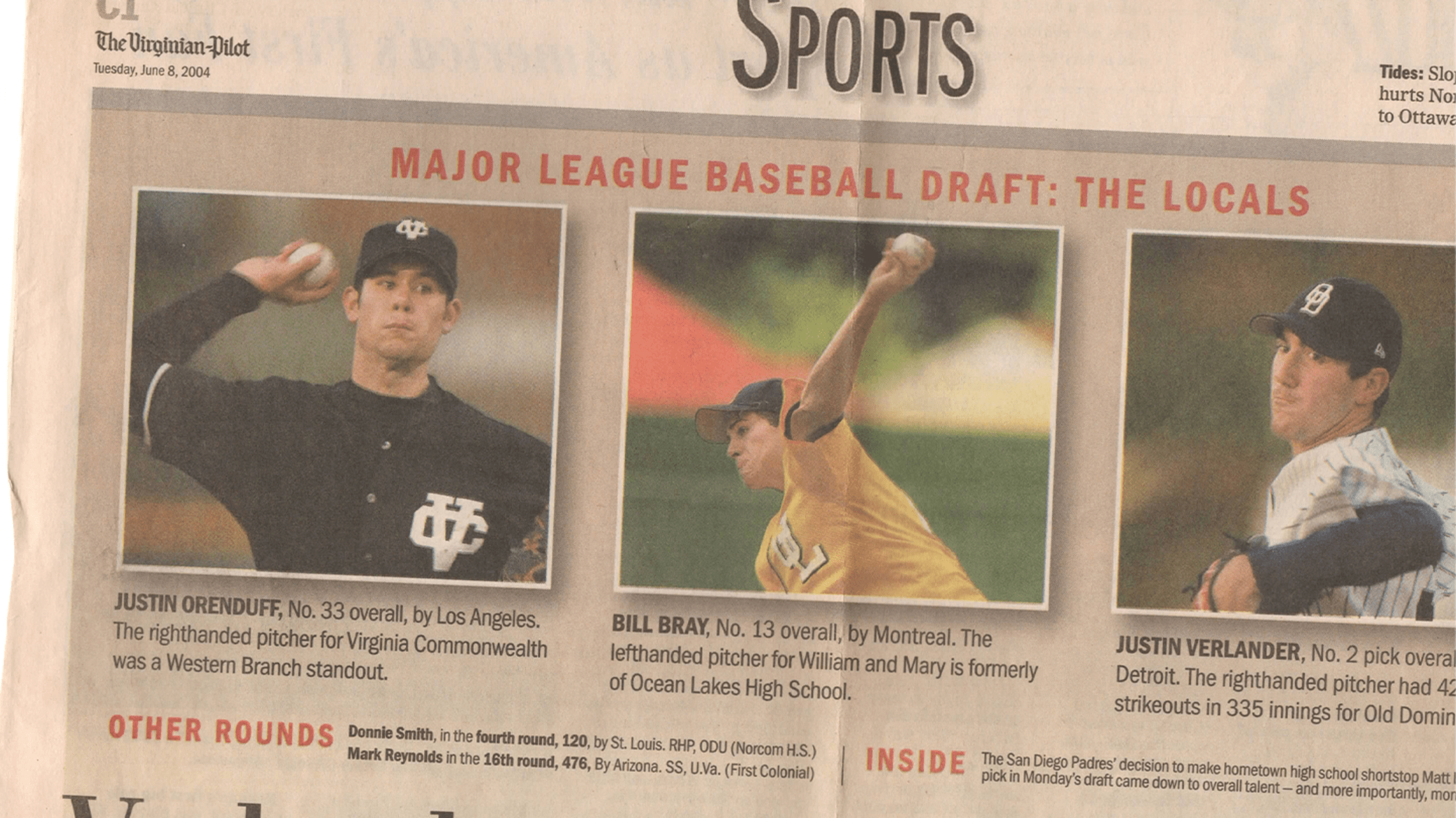
PRO BALL AND DIVERGENT PATHS
After both Justins signed, Orenduff got his professional feet wet in the rookie-level Pioneer League that summer while Verlander wouldn’t get started until the 2005 season. Orenduff was on a fast track; he made it to Double-A in 2005 and was part of one of the best Minor League teams in history, a Jacksonville Suns roster that featured an astounding 17 future big leaguers -- including eventual All-Stars like Edwin Jackson, Russell Martin and Joel Hanrahan -- at one point or another. He returned to Jacksonville in 2006 and was almost called up to the big leagues that year when there was a hole in the Dodgers’ rotation. Chad Billingsley got the call instead, which was just as well because that was when Orenduff first started experiencing the shoulder issues that would effectively end his career by 2009 (though he made one comeback attempt in 2011).
If Orenduff was on the fast track, Verlander was on a bullet train. He made 13 starts in High-A Lakeland to begin his pro career and then was bumped to Double-A Erie. He made his big league debut that July, pitched in the Futures Game, took the ball seven times with Erie in total and made one more Major League start. That was the end of his Minor League time; he would lead the Tigers to the World Series and win American League Rookie of the Year honors in 2006, the first step in polishing a plaque in Cooperstown.

While Verlander was piling up numbers and awards, Orenduff used his career experiences to set off on a different path. He wanted to learn and know the why behind his injury issues and has made it his life’s work to study pitching mechanics and help others try to avoid the pitfalls of throwing a baseball from a mound. He founded DVS, Delivery Value System, in 2014, and continues the work to this day as pitchers seem to be sidelined on a daily basis.
It was this work, and the common bond of pitching, that brought the Justins back together. The two had reconnected at a Halloween party Orenduff was hosting, one that he promises he still has photos from.
“Oh God, please don’t share those,” Verlander said with a laugh.
“Very quickly after our careers went in different directions, we were both from the same area, knew a lot of the same people,” Verlander said. “I went to the party and we hit it off. We established a relationship. You never know when you’re going to meet a life-long friend.
“I’m thankful to be able to still call you a friend,” Verlander told Orenduff. “I don’t have a lot of friends from that time in my life. It’s hard for me to connect with a lot of people. You’re one of those.”
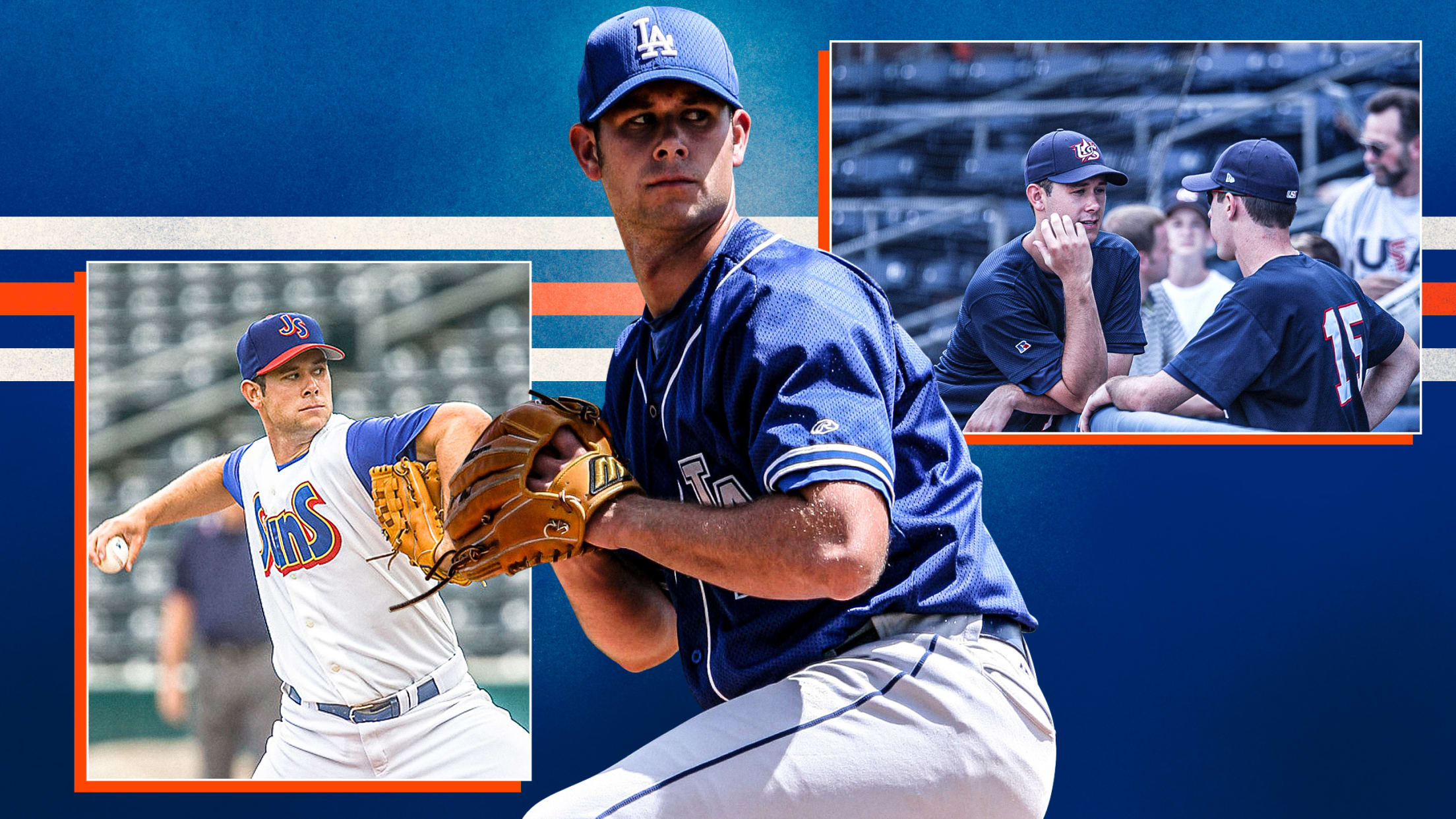
Orenduff remembers the precise moment when he was able to bring his new expertise to a re-formed friendship. He was in Detroit to watch Verlander pitch against the Blue Jays. It was June 5, 2014. Orenduff had just started DVS and he was watching his former rival and realizing that something wasn’t quite right. Verlander had had core muscle surgery that January, something he later said he felt was misdiagnosed. There was a back tear that was eventually treated and shoulder stiffness.
Orenduff felt it was a time he could try to inject some analysis into their relationship.
“As your friend, sitting behind home plate, here are some things I observed that are different from what I’m used to observing from you,” Orenduff said while watching Verlander toe the rubber against the Nationals. “I said take it for what it’s worth; I’m just going to pass along the information.”
Verlander was the perfect receptacle, a warehouse of pitching knowledge who is, to this day, a sponge and a self-professed tinkerer. It also helped that Orenduff isn’t the kind of over-bearing friend who was constantly lighting up Verlander’s phone to give unsolicited advice. From that first moment on, they would have regular check-ins, maybe once or twice a year, to discuss the art and science of the craft.
“I know all the work he puts in behind the scenes,” Verlander said. “To be able to call him and talk about pitching mechanics, just somebody who’s seen me for so long, knows me so well, to be able to call and pick his brain about mechanics is something I don’t take for granted.
“I’m somebody who loves information, who loves to talk pitching, who loves baseball. A lot of times when I’m searching for something, [I use] a lot of different avenues. I like to garner information from people I respect and like talking to. And he’s one of those guys. It’s a very small circle for me. I really like the way he thinks, the way his brain works, all the research you’ve done and how you know me so well. It works well.”
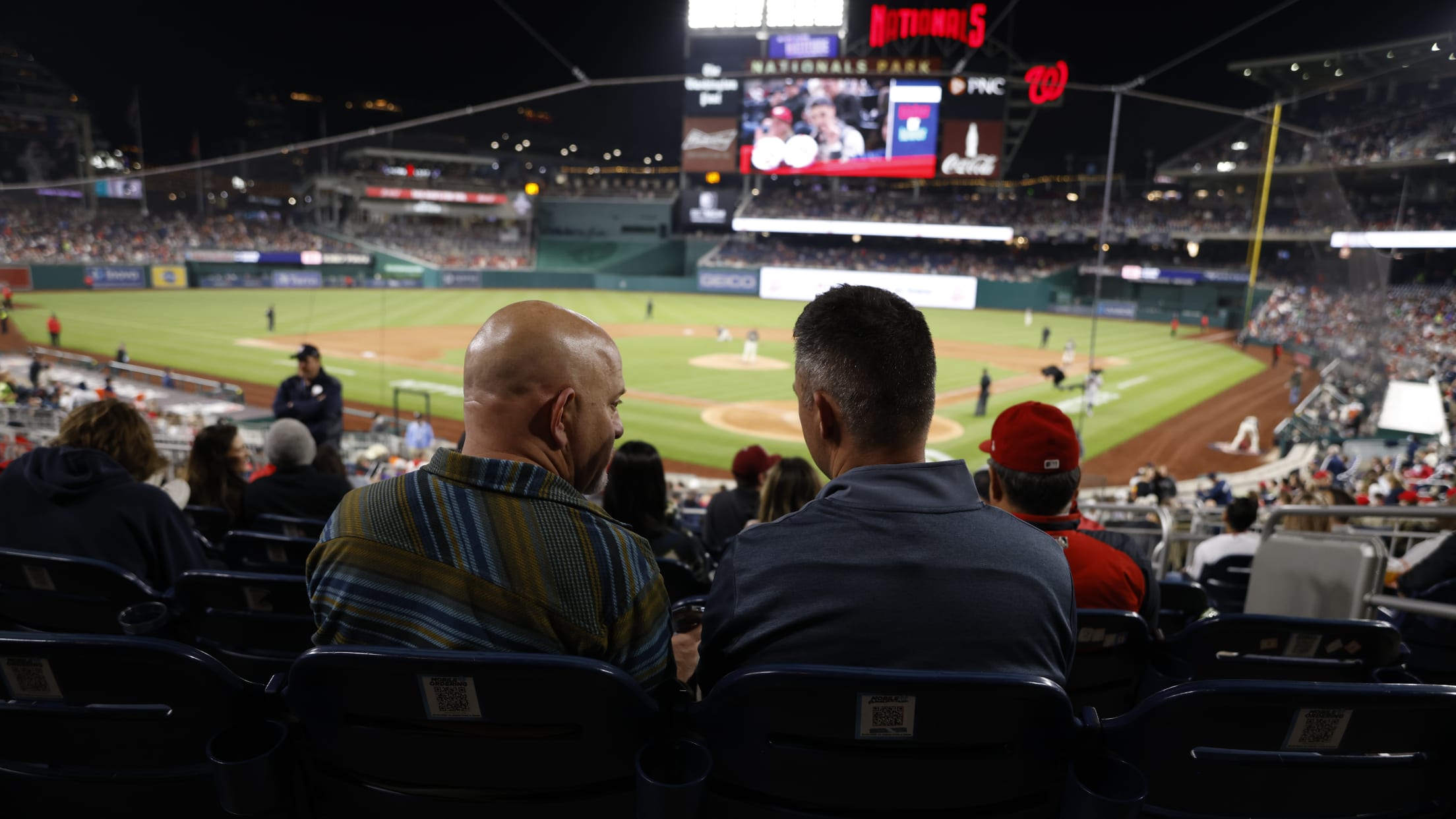
WHAT THE FUTURE HOLDS
Verlander and Orenduff couldn’t help but laugh when watching the 2004 version of themselves, joking over the Major League Scouting Bureau video they were shown.
“Why did anyone draft me? I look like Nuke LaLoosh,” Verlander quipped.
Both Justins dreamed of pitching in the big leagues back then. One made it, and the other is helping him beat back Father Time. While most 21-year olds can’t envision what they are doing the next week, let alone 20 years later, it shouldn’t surprise anyone that Verlander was more than willing to look into that crystal ball.
“I for sure imagined it,” Verlander said. “My idol was Nolan Ryan, who played into his late 40s. That’s always what I envisioned. I also have perspective now and realize how fortunate I am to be in this situation. I don’t take it for granted, especially after going through some injuries in my career and realizing it could have been the end and all the work to come out the other side.
“I guess I always envisioned myself here, but now that I’m here, I realize how ignorant it was to think that I could do this. But that same thought process got me here.”
While Orenduff watched his friend go six strong innings for a win against the Nationals in his 2024 debut, he wondered if he was watching the last of a dying breed. The two talked later about goals -- 300 wins, throwing 95 mph at age 45 -- with Verlander promising, “I’m not going to go out there and make a fool of myself. The game will tell you if you can’t be successful anymore. I don’t know if at 45 I’ll be able to pitch to the level I have in my late 30s, or my mid-20s. But I might be able to.” Orenduff posited that regardless of what happens from here, watching what Verlander can still do now should not be under-appreciated.
“You're watching the now first-ballot Hall of Famer pitch and do things that at 41 years old, maybe he's the last traditional starting pitcher to do these things, and thinking about why he does it and what has led to that,” Orenduff said. “And for what we talk about of mechanics and timing, there's a reason of over the years, things that he knows, and what he tries to aspire to perfect, that we talked about, it has helped him do it.”
Verlander, for his part, dismisses the idea that he’s a dinosaur about to go extinct.
“I don’t know if that’s true,” he said. “You had your once- or twice-a-generation player. I’m not going to be compared to Roger Clemens or Randy Johnson. Those guys aren’t compared to Nolan Ryan. Nolan Ryan’s not compared to Bob Gibson. Bob Gibson … you can keep going. Nobody is going to win 500 games again. Nobody is going to throw 300 pitches in a game again.
“This has been what’s happening. But there will be somebody who comes along who will push the boundaries of what’s possible, inside the boundaries of what’s allowed in the game today. I was allowed to throw 120, 130 pitches on occasion. The old guys, Nolan, Bob Gibson, would laugh at that. The game is constantly adapting. Would I like to see it go back and revert a little bit? Of course. You’re going to have people who will come along and push those boundaries.”
